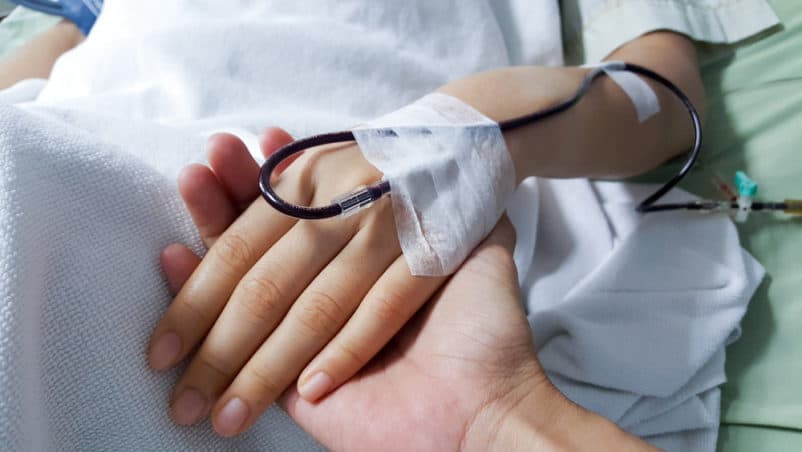Contents:
- Medical Video: Living with A Rare Blood Cancer, Polycythemia Vera
- Treatment for leukemia blood cancer options
- 1. Chemotherapy
- 2. Biological therapy
- 3. Target therapy
- 4. Radiation therapy
- 5. Stem cell transplantation
- Choice of treatment of lymphoma blood cancer
- 1. Active surveillance
- 2. Chemotherapy
- 3. Drug therapy
- 4. Radiation therapy
- 5. Bone marrow transplant
- Treatment options for myeloma blood cancer
- 1. Target therapy
- 2. Biological therapy
- 3. Chemotherapy
- 4. Corticosteroids
- 5. Stem cell transplantation
- 6. Radiation therapy
Medical Video: Living with A Rare Blood Cancer, Polycythemia Vera
During this time you may have often heard of leukemia, one type of blood cancer that most often occurs in the community. In fact, there are two other types of blood cancer that are also worth watching out for, namely lymphoma and myeloma. Each type of blood cancer has different treatment methods, you know. Do not let lymphoma blood cancer treatment be equated with leukemia.
Treatment for leukemia blood cancer options
Leukemia is a type of blood cancer that affects the production and function of white blood cells in fighting infection. If you suffer from leukemia, the body will make many abnormal white blood cells (leukemia cells) and destroy normal white blood cells in the body. As a result, infections and inflammation arise throughout the body.
Before undergoing leukemia treatment, the doctor will conduct a number of examinations first. Starting from general health tests, types of leukemia, and how much impact leukemia has on your body. After that, a new doctor can determine which leukemia blood cancer treatment is right for you, including:
1. Chemotherapy
Most cases of leukemia are treated with chemotherapy to kill leukemia cells that gnaw at the patient's body. Depending on the type of leukemia, you may be given a single dose or several drugs at once. The form can also be a chemotherapy drug to drink or inject intravenously.
2. Biological therapy
Biological therapy serves to help "provoke" your body's immune system to fight leukemia cells. It's easy like this, you will be given certain drugs whose function is to strengthen your immune system. Once your "new" immune system is formed and is stronger, then you will be better able to fight cancer cells that eat away at your body.
3. Target therapy
Not much different from chemotherapy, target therapy uses other additional drugs to help the body attack leukemia cells. The difference is, this therapy is more specifically targeted at the body parts that have many cancer cells. One of them, the drug imatinib (Gleevec) can stop protein activity in leukemia cells so that the spread can be prevented.
4. Radiation therapy
Radiation therapy generally uses X-rays or high-energy rays to damage leukemia cells and stop their growth. Before the process starts, you will be asked to lie on a flat surface, then a large machine will direct radiation to certain points on your body.
Depending on the extent of the spread of leukemia cells in the body, you may only receive radiation in one particular area of the body or maybe throughout the body. This therapy is usually one of the conditions for those of you who want to undergo stem cell transplantation.
5. Stem cell transplantation
Stem cell transplantation is a procedure for replacing bone marrow infected with leukemia cells with healthy bone marrow. The frequency of this treatment is usually done for leukemia patients who are under 55 years old.
Before stem cell transplantation begins, you will be given high-dose chemotherapy drugs or radiation therapy first. The goal is to help destroy your bone marrow that has been infected by leukemia cells. The stem cells used are generally from other people's spinal cord donors, but in some cases can use the patient's own stem cells.
Choice of treatment of lymphoma blood cancer
Lymphoma is often misinterpreted by leukemia. Although both blood cancers, lymphoma starts from the appearance of cancer in the lymph nodes and white blood cells lymphocytes.
Basically, treatment of lymphoma blood cancer is also not much different from leukemia. Here's the explanation.
1. Active surveillance
Lymphoma cancer cell growth tends to be very slow. That is why, the first step that must be done is to carry out active surveillance. That means the doctor will wait and monitor the extent to which lymphoma cells grow in your body to cause symptoms.
2. Chemotherapy
Just as before, most chemotherapy is done to treat any type of blood cancer. This treatment is done to kill cancer cells that are lodged in your body, both using chemotherapy drugs to drink and by IV.
3. Drug therapy
In addition to chemotherapy drugs, doctors may give other drugs that are more effective against lymphoma cancer cells specifically. Usually immunotherapy drugs are used to boost your immune system in fighting cancer cells.
4. Radiation therapy
Treatment of lymphoma blood cancer can also be done with radiation therapy. This therapy uses high-energy rays, such as X-rays and protons, to kill cancer cells.
5. Bone marrow transplant
Bone marrow transplantation is done by replacing bone marrow infected with cancer cells with healthier new bone marrow. However, you are usually recommended to undergo high-dose chemotherapy and radiation first to help destroy the already damaged bone marrow.
Treatment options for myeloma blood cancer
Myeloma or multiple myeloma is the second most common type of blood cancer. Myeloma itself is a type of cancer that is formed from malignant plasma cells that grow uncontrollably in the body.
Although it is considered incurable, this disease can still be treated thanks to advances in cancer research today. Treatment options for blood cancer myeloma include:
1. Target therapy
Target therapy for treating myeloma is actually not much different from the target therapy for leukemia and lymphoma. The types of drugs that are often used in this therapy include bortezomib (Velcade), calfilzomib (Kyprolis), and ixazomib (Ninlaro). The function of these drugs is the same, namely blocking protein breakdown in myeloma cells so that the cancer cells do not spread more in the body.
2. Biological therapy
Biological therapy relies on your body's own immune system to fight myeloma cancer cells. Doctors usually use the drug thalidomide (Thalomid), lenalidomide (Revlimid), and pomalidomide (Promalyst) to strengthen your immune system before fighting cancer cells.
3. Chemotherapy
Chemotherapy is the type of treatment most often relied on to kill cancer cells. Obviously, effective chemotherapy drugs damage cancer cells and stop their growth.
4. Corticosteroids
Corticosteroids, such as prednisone and dexamethasone, can help stimulate the body's immune system to reduce inflammation. The drugs available in the form of pills and intravenous fluids are also considered effective against myeloma cells in the body.
5. Stem cell transplantation
As with leukemia and lymphoma, stem cell transplantation can help provide healthier bone marrow for myeloma blood cancer patients. These stem cells will rebuild the patient's bone marrow that was previously damaged, so that it can function properly.
6. Radiation therapy
Radiation therapy uses high-energy rays, both X-rays and protons, to stop the growth and spread of cancer cells. This therapy is used to kill myeloma cells specifically and faster. For example, when myeloma cells invade the plasma to damage bone, radiation therapy will focus on bone plasma.















